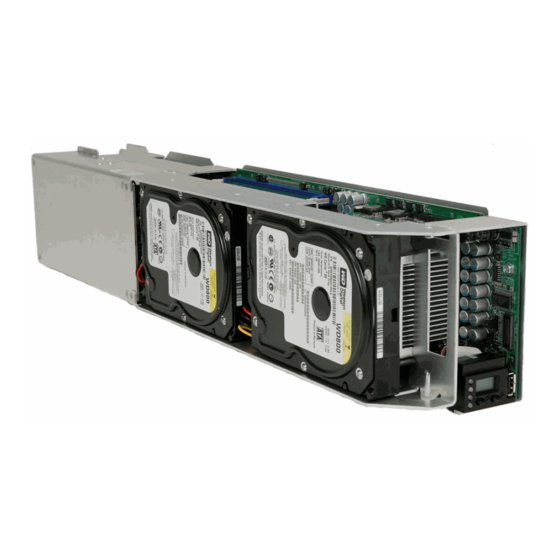ClearCube R2200 Handleiding locatievoorbereiding - Pagina 6
Blader online of download pdf Handleiding locatievoorbereiding voor {categorie_naam} ClearCube R2200. ClearCube R2200 9 pagina's. Delayed start-up when cmos battery
Ook voor ClearCube R2200: Technisch document (1 pagina's), Release Release (1 pagina's), Snelstarthandleiding (2 pagina's), Technische opmerkingen (1 pagina's)

COOLING AND ENVIRONMENTAL REQUIREMENTS
Each ClearCube R Series chassis holds up to eight single
processor blades or four dual processor workstation blades
and their associated hard drives, memory and power
supplies.
This concentration of electronics generates a
significant amount of heat, even when the equipment is not
operating at full capacity. While the chassis can exceed
5100 BTU/Hr with all Blades operating at peak power,
nominal usage will result in heat rates between 3100 and
3850 BTU/Hr. ClearCube recommends a cooling system
designed to remove 3850 BTU/hr of heat.
cooling
capacity,
every
approximately 1.3 tons of additional cooling at the location
where they are installed.
The acceptable thermal range for operating blades and
chassis is from 0 to 35 °C (32 - 95 °F).
outside this range will damage the internal electronic
components, regardless of whether the event is a brief spike
or a sustained condition. If blade temperatures exceed the
acceptable range and components fail, this will void the
product warranty.
Cooling capabilities of the HVAC system will be severely reduced without proper ventilation and
airflow through the chassis. In an open rack, chassis require five inches of clearance at the rear
of the fans to allow airflow. Care must be taken in organizing cable bundles to not disrupt this
airflow, which will necessitate the use of cable ties and guides. For chassis held in cabinets or
other enclosures, a fan at the top of the cabinet will be required to ensure hot air does not
stagnate in the enclosure. Proper room ventilation ducting is vital to ensuring that air heated by
the blades doesn't continuously circulate in the room. Regardless of the cooling system capacity
installed, waste heat from the blades should be directly vented to the environment. If waste heat
from the blades isn't properly vented, a closed loop circulation system could form leading to
excessive room temperatures. This is true even if the installed cooling system has excess
cooling capacity because heated, re-circulated air can enter the chassis intakes.
In terms of
three
chassis
will
Temperatures
In addition to thermal considerations, the
blades must be kept in a relatively clean
environment. The electronic circuitry on the
blades and chassis modules is not protected
from airborne contamination by dust or
chemicals. Therefore, the chassis must be
kept
concentrations of contaminants.
6
Installation Experiences:
While data centers are often well
equipped to handle the heat load,
other
rooms
telecommunications closets and
spare backrooms may need duct
work to bring in more ventilation
from the central cooling system.
Lacking
this
require
temperatures above 100°F are
easily reached, which can cause
blades
and
prematurely fail.
prevent
this,
certified
Systems
should verify that the installation
site has been properly prepared
to provide sufficient cooling.
away
from
areas
such
as
ventilation,
chassis
to
In order to
a
ClearCube-
Engineer
with
high
